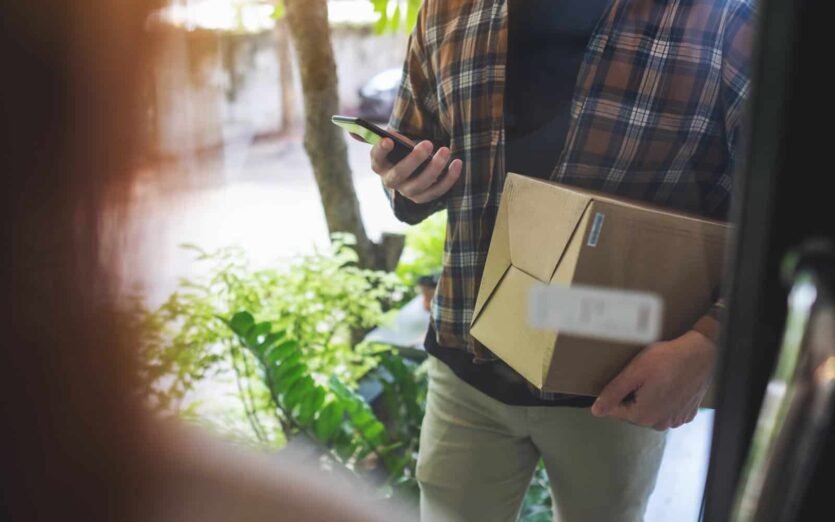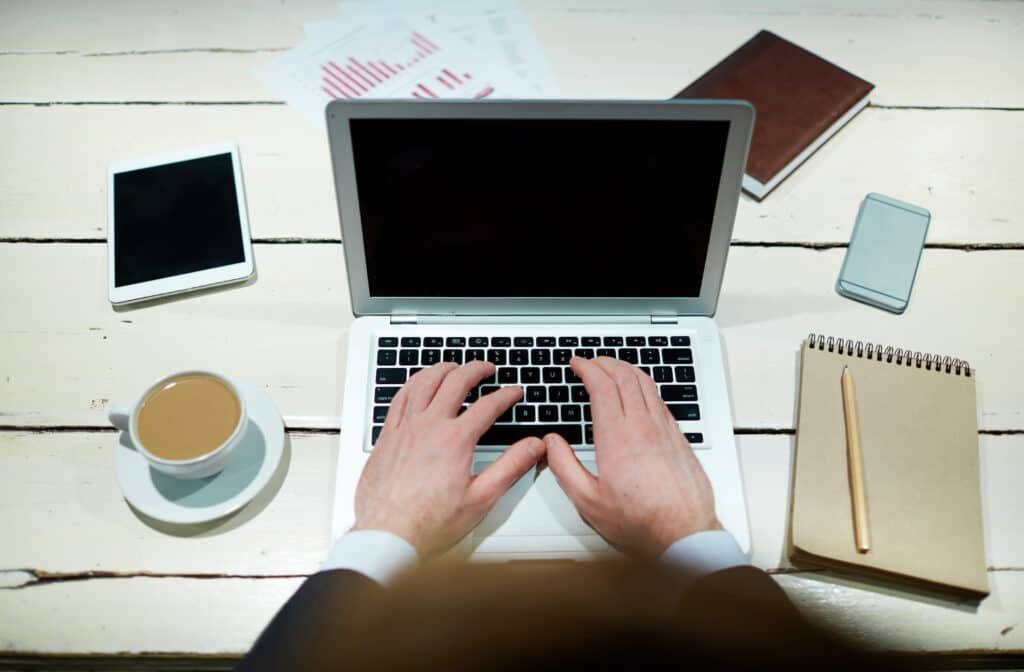Protect Yourself from Parcel Delivery Scamming Now!

We may earn a small fee from the companies mentioned in this post.
Imagine eagerly awaiting a parcel you ordered online, only to receive a text message claiming there’s an issue with the delivery. You follow the instructions in the message, and before you know it, you’ve fallen victim to a parcel delivery scamming.
It’s a frustrating and disheartening experience that’s becoming all too common. In this blog post, we’ll dive into the world of parcel delivery scamming, how to recognise them, and what you can do to protect yourself and your hard-earned money.
Parcel delivery scamming has surged in recent years, with cybercriminals taking advantage of the rise in online shopping to deceive victims and steal their personal and financial information.
By understanding the tactics used by scammers and learning how to recognise red flags in suspicious text messages, you can avoid falling prey to these schemes and enjoy a safer online shopping experience.
Key takeaways – Parcel delivery scamming
Be aware of common parcel delivery scams and stay informed on the latest initiatives for consumer protection.
Recognise red flags associated with scam text messages & emails, verify contact information, and update payment preferences to protect against falling victim.
Report suspected scams to help protect yourself and others while contributing to increased internet safety.
Understanding parcel delivery scams

Parcel delivery scams are fraudulent activities where criminals send messages pretending to be from delivery companies to deceive victims and steal their personal and financial information.
These scammers tend to be vague about the source of the parcel and its contents, directing you to a fraudulent website to obtain your personal information. Some examples of parcel delivery scams include:
The Evri Parcel Scam Text
Fake parcel text scams
The Royal Mail Scam
Smishing texts
Guarding against parcel delivery scams requires the following steps:
Caution with links and attachments
Verification of contact details
Updating payment settings
Staying abreast of national initiatives like the Take Five Campaign and the Citizens Advice Consumer Service
We will delve deeper into these strategies, offering practical advice on defending yourself against such scams in the subsequent sections.
Checkout our informative article on Smishing
The Rise of Online Shopping
The rise of online shopping has revolutionised the way consumers shop, with over 2.14 billion shoppers now buying items online. The COVID-19 pandemic further accelerated the growth of online shopping, leading to a significant increase in online purchases during the pandemic.
As a result, parcel delivery scams have become more prevalent, especially during the holiday season when more people are expecting packages.
Scammers take advantage of the increased number of parcels being delivered during peak shopping periods like Christmas to target unsuspecting victims.
Always confirm delivery notifications from the delivery company and maintain alertness when receiving messages regarding missed delivery of your online purchases to fend off parcel delivery scams.
Common Types of Scams
Common types of parcel delivery scams include fake delivery notifications, phishing emails, and smishing texts. Cybercriminals use these tactics to lure victims into accessing seemingly legitimate websites designed to steal their personal information.
Additionally, buyers on online marketplaces like Facebook Marketplace may encounter courier scams, where fraudulent payment receipts are sent, and sellers are asked to give bank details and enter personal name to pay the courier fee. If the seller complies, the buyer may then break contact, and the item remains uncollected.
Other parcel delivery scams, including package delivery scams, may involve:
Texts or emails claiming to be from a delivery company, asking to reschedule or request additional delivery fees
Notifications about a failed delivery of a package to your address
Phishing emails and texts impersonating delivery companies
Knowledge of these prevalent scams will enable you to identify and steer clear of them.
You may find our informative article on Royal Mail fee to pay scam useful
Recognising scam text messages and emails

The ability to discern scam text messages is key in defending against parcel delivery scams. A scam text message is a deceptive communication designed to deceive or mislead individuals into providing personal information, financial or banking details or, clicking on malicious links.
These messages may appear to be from legitimate organisations or individuals, claiming that the recipient has won a prize, and must verify bank their account information, or has a package waiting for delivery.
We will subsequently outline the red flags in scam messages and discuss delivery notification verification methods to prevent falling prey to these scams.
Red flags to look out for
Some red flags in scam messages include these scam texts:
Suspicious phone numbers
Spelling errors
Grammatical errors
Pressure to act quickly
For example, DPD scam texts typically contain a link prompting the reader to re-direct, re-deliver, or pay duties on a parcel. Another warning sign is the urgency request and to take action promptly, which scammers use to make victims feel pressured and more likely to comply with their demands.
Awareness of these warning signs enhances your ability to spot scam messages and dodge parcel delivery scams. Remember, if something seems too good to be true or raises suspicion, it’s better to be safe than sorry.
Checking delivery notifications
Direct verification from the delivery company is vital to authenticate delivery notifications. You can check delivery notifications by logging into the delivery service’s website, downloading their app, or signing up for email or text notifications. This will ensure that you stay informed about the status of your own package deliveries and can detect any potential issues or delays.
If you encounter any issues with delivery notifications, such as incorrect information or delays, it’s recommended to contact the delivery service directly. They will be able to provide further information and assist in resolving any issues. In addition, always ensure the website or app being used is a legitimate site and that the email or text message is from a trusted source.
Concerned about Royal Mail email scams? Read our informative blog and learn how to protect yourself.
How to avoid falling victim to parcel delivery scams

To avoid falling victim to parcel delivery scams, remember to:
Exercise caution when dealing with links and attachments
Verify contact information before responding or making payments
Update your payment preferences with delivery companies
By taking these simple precautions, you can significantly reduce the likelihood of being deceived by scammers and protect your personal and financial information.
We will delve into these strategies more comprehensively in the upcoming subsections, delivering practical advice to fortify your defense against parcel delivery scams.
Be cautious with links and attachments
A crucial safeguard when encountering scam messages is to refrain from clicking on links or downloading attachments embedded in suspicious communications. These links and attachments may contain malicious software or direct you to websites designed by criminals you to steal your personal information.
If you receive a message regarding a missed delivery, proceed with caution and be wary of any requests for personal information.
If you have inadvertently clicked on a dubious link or attachment, immediately sever your device’s internet connection and consult your broadband network provider, or a cybersecurity expert. Acting quickly can help minimise the potential damage caused by these scams.
Verify contact information
Confirming the provided contact information is a necessity before responding to messages or making payments. This can help ensure that you’re dealing with a legitimate party and not falling victim to a scam.
To verify contact information, you can conduct an online search, contact mobile number of the recipient directly, or reach out to the network provider or delivery company to confirm the recipient’s identity.
If you have any queries related to a payment or suspect that a message might be a scam, contact the recipient to confirm the payment details or report the message to the appropriate authority. This can help protect both you and others from falling victim to the parcel delivery scam and mobile messaging scams.
Update payment preferences

Maintaining updated payment preferences with delivery companies is essential for reducing the risk of fraudulent activity. Ensure that your payment preferences are current to safeguard against potential scams.
If you have any difficulties updating your payment preferences, don’t hesitate to contact the delivery company directly for assistance.
Dealing with suspected scams

If you believe you have received a parcel delivery-related or scam email or message, it’s of utmost importance to report it and notify the delivery company. Reporting suspected scams can help protect yourself and others from falling victim to these schemes.
The subsequent subsections will guide you on how to report scam messages and emphasise the significance of informing the delivery company about potential scams.
Reporting scam messages
To report a scam message, you can forward it to 7726 or the appropriate authority. Reporting scam messages is crucial for safeguarding yourself and others, recognising new scams, interrupting scam networks, preserving personal information, and increasing awareness.
By reporting suspected scams, you’re not only protecting yourself from cyber criminals, but also contributing to the collective effort to combat these malicious activities and make the internet a safer place for everyone.
Alerting the delivery company
Alerting the delivery company about potential scams is vital for protecting yourself and others from parcel delivery scams. To do this, you can contact the company through their website or customer service number and provide the required information concerning the delivery scam.
Additionally, keeping your contact information updated with the delivery company can help ensure they can contact you in case of any delivery-related issues. By staying vigilant and reporting any suspicious activity, you’re helping to create a safer online shopping environment for everyone.
Staying safe on online marketplaces

It’s vital to stay alert about potential parcel delivery scams and adopt necessary protective measures when shopping on online marketplaces.
By being wary of upfront fees and checking user profiles and reviews, you can minimise the risk of falling victim to these scams.
The upcoming subsections will delve deeper into these strategies while offering practical guidance on maintaining safety in the online marketplace.
Be wary of upfront fees

Forking out upfront fees to unfamiliar sellers or buyers carries a risk, as scammers commonly exploit this to dupe individuals, pocketing their money without delivering the promised service or product.
It’s important to be mindful of upfront fees when dealing with unknown sellers or buyers, including those for services such as delivery, processing, customs fee, or handling.
To avoid incurring upfront fees, research the seller or buyer before making any payments, read reviews, and look for any red flags. Additionally, use a secure payment method, such as a credit card or PayPal, to ensure the safety of your funds.
Check user profiles and reviews
Confirming user profiles and reviews is a key step in ascertaining the authenticity of a person or product. To verify user profiles, review details of online accounts, such as the user’s name, contact information, and any reviews or ratings they have received. Additionally, examine any website or social media accounts associated with the user.
When reading reviews, take note of details such as the reviewer’s name, the date of the review, and the content of the review. Pay particular attention to any negative reviews and take steps to verify the accuracy of the information. By being diligent in checking user profiles and reviews, you can avoid falling victim to parcel delivery scams on online marketplaces.
National campaigns and resources

Numerous national campaigns and resources, including the Take Five campaign and the Citizens Advice Consumer Service, are at your disposal to fortify your defense against parcel delivery scams. These initiatives provide valuable information and support for those affected by package delivery scams everywhere, ensuring that you’re well-equipped to protect yourself and your finances.
The next subsections will delve into these campaigns, thier respective websites and resources, highlighting the advice and support they offer to help you evade parcel delivery scams.
Take five campaign
The Take Five campaign is a national initiative that offers guidance on how to protect one’s bank account from phishing, smishing, and online fraud.
The national campaign also encourages individuals to pause and reflect before sharing personal information or making financial transactions, challenge any requests that seem suspicious, and report any potential scams to the bank and Action Fraud.
By following the advice of the Take Five campaign, you can significantly reduce your risk of falling victim to parcel delivery scams and enjoy a safer online shopping experience.
Citizens advice consumer service
The Citizens Advice Consumer Service offers impartial advice:
Free advice and support to individuals who may have been the victim of a scam or are at risk of becoming a victim
Guidance on how to report a scam
Tips on how to safeguard oneself from potential scams in the future
If you believe you’ve fallen victim to a parcel delivery scam or need advice on how to protect yourself, don’t hesitate to contact the Citizens Advice Consumer Service for assistance.
Summary
In conclusion, parcel delivery scams are an unfortunate reality in our increasingly digital world. By familiarising yourself with common scams, learning to recognise red flags in suspicious emails and messages, and taking precautions when dealing with links, attachments, and contact information, you can protect yourself and your finances from these malicious schemes.
Remember, staying vigilant and informed is your best defense against parcel delivery scams. By following the advice and strategies outlined in this blog post, you can enjoy a safer and more secure online shopping experience.
Frequently Asked Questions
Why would a scammer send me a package?
Scammers may send you a package as part of an attempt to trick you into entering your card details on a fraudulent website, install malware on an app or click a link to fake websites that contains spyware to gain access to your personal and banking information.
How to stop buying from china?
To stop buying products from China, make sure to get the order ID, the number of packages received, and take a photo of the shipping label. Contact the e-commerce retailer’s customer support centre and provide information about the box sent to you to start the process.
Who sent me an amazon package?
Amazon Customer Service is the best way to find out who sent you an Amazon package. To do this, provide them with package details such as description, date and time received, and package number.
What are some common types of parcel delivery scams?
Common parcel delivery scams include fake delivery notifications, phishing emails, and smishing texts.
How can I recognise a scam text message or email?
Be wary of suspicious phone numbers, grammatical errors, and spelling mistakes and requests to act quickly; these are all red flags of a scam.
Useful external resources
1. Action Fraud
- Website: Action Fraud
- Information: Action Fraud is the UK’s national reporting centre for fraud and cybercrime. Their website contains reports on the latest scams, including parcel delivery scams, and offers prevention advice.
3. Citizens Advice
- Website: Citizens Advice
- Information: Citizens Advice provides information on how to identify scams and what steps to take if you’ve been scammed, including parcel delivery scams.
5. Royal Mail
- Website: Royal Mail
- Information: Royal Mail’s official website contains a section that educates consumers on recognising and reporting scams, including those that misuse the Royal Mail name in parcel delivery scams.
With over three decades of experience in the heart of London’s financial sector, I have dedicated my career to the pursuit of robust cybersecurity practices and IT leadership. As a Certified Information Systems Security Professional (CISSP), Certified Information Security Manager (CISM), Certified Chief Information Security Officer (C|CISO), Certified Ethical Hacker (CEH), and Computer Hacking Forensic Investigator (CHFI), I bring a wealth of knowledge and expertise to the table.
My journey in the field of cybersecurity has not only been about personal growth but also about sharing my insights with others. As an international speaker, I have had the privilege of addressing audiences worldwide, discussing the importance of cybersecurity in today’s digital age. My passion for knowledge sharing extends to my work as an author and blogger, where I delve into the complexities of cybersecurity, offering practical advice and thought leadership.
In my role as a CISO and Head of IT, I have overseen the development and implementation of comprehensive information security and IT strategies. My focus has always been on creating resilient systems capable of withstanding the evolving landscape of cyber threats.
My Master’s degree in Cybersecurity has provided a solid academic foundation, which, when combined with my practical experience, allows me to approach cybersecurity from a holistic perspective.
I am always open to connecting with other professionals in the field, sharing knowledge, and exploring new opportunities. Let’s secure the digital world together.

